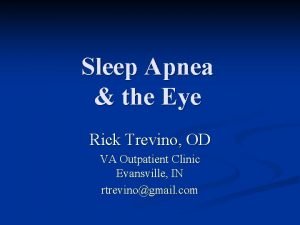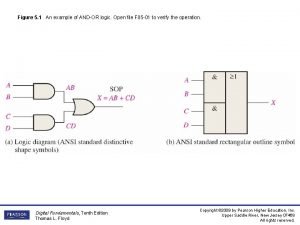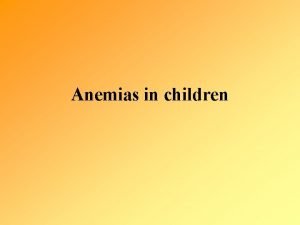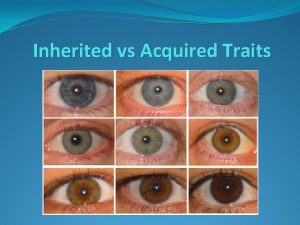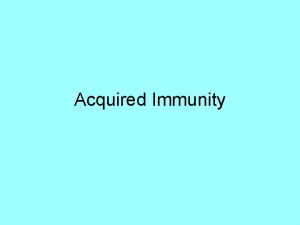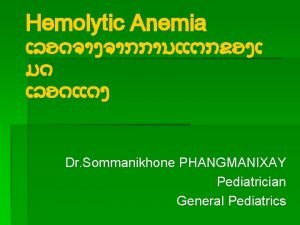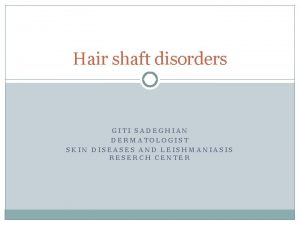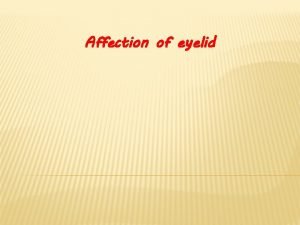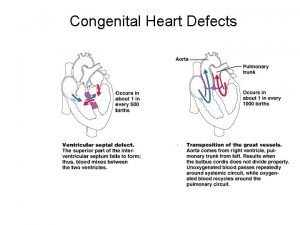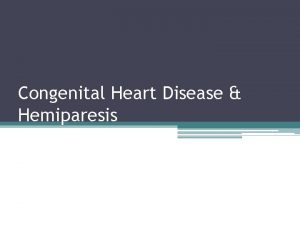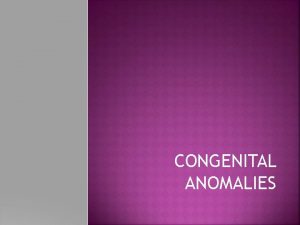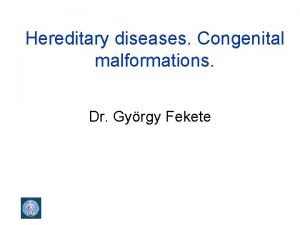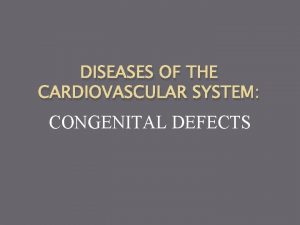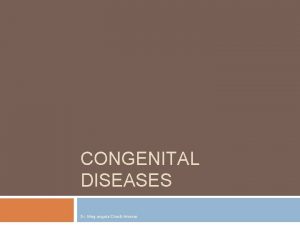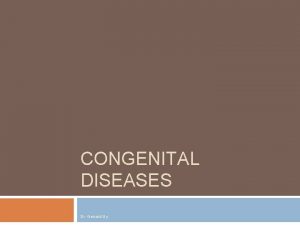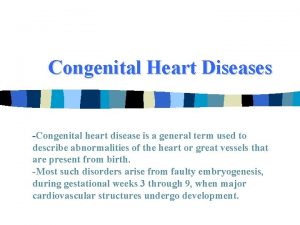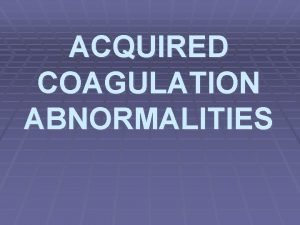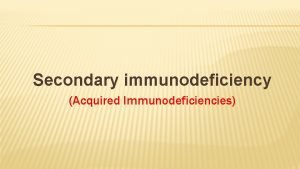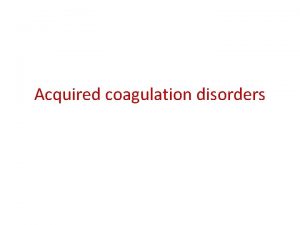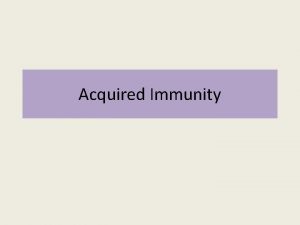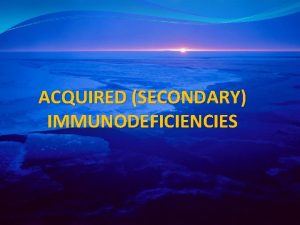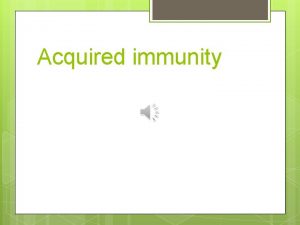Eyelid Diseases Congenital andor acquired diseases Congenital Diseases




























- Slides: 28

Eyelid Diseases Congenital and/or acquired diseases

Congenital Diseases 1 - Atresia of the eyelid : Absence of the eyelid 2 - Coloboma ( notching of the eyelid): Absence of a segment of the full thickness of the eyelid 3 - Dermoids: congenital tumour-like mass of tissues may affect the eyelids only or extend to the conjunctiva and/or cornea. Numerous long hair are present on the surface of the dermoid

4 - Distichiasis: presence of a second abnormal row of eyelashes. The cilia originate from abnormally located follicles which emerge from or just posterior to the openings of the Meibomion glands ( it differs from trichiasis, districhiasis and ectopic cilia). Clinical symptoms: Blepharospasm, conjunctivitis, keratitis and corneal ulceration - Distichia are usually multiple ( from 5 -10 cilia) and difficult to seen as they are thin and lightly pigmented. When multiple eyelashes are seen emerging from a single follicle it is called ( districhiasis ) Treatment: epilation by cilia forceps or electro epilation

5 - Ankyloblepharon: Fusion of the upper and lower eyelids along the eye margin. It is normal in the first 15 days of life. Delayed opening may leads to infection with Staphylococcus resulting in ophthalmia neonatorium. -Treatment: application of hot compresses and the line of fusion is separated by a blunt scissors

Acquired Diseases 1 - Trichiasis: the cilia arising from the normal sites are directed toward the eye and contact the cornea and conjunctiva. It may be acquired following injury to the eyelid. Clinical symptoms: presence of abnormally directed cilia towards the eyeball - Epiphora, Blepharoplasm, corneal ulceration and chronic conjunctival erythema. Treatment: 1 - Forceps epilation, if it few in number 2 - Electro epilation 3 - Operation of entropion or surgical removal of dermoids when it is the cause.

Continued: 4 - Removal of a V- shaped segment of the tarso- conjunctiva containing cilia 5 - Entropion surgical technique may be used to treat distichiasis by everting the eyelid margin, thereby redirecting the distichia away from the eyeball. 6 - lid splitting operation.

2 - Ectopic cilia: single or multiple cilia are emerging from the conjunctival surface of the eyelid. Symptoms: presence of ectopic cilia at the palpebral conj. , 2 -6 mm from the eyelid margin. - Vascularization of the adjacent parts of the cornea accompanied by an elongated superficial corneal ulcer. - Conjunctivitis especially at the bulbar conjunctiva - Blepharospasm and epiphora Treatment: Electro epilation - Surgical removal of the cilia with part of tarso-conjunctiva containing the follicle.

3 -Chalazion: Syn. , Meibomian cyst – Tarsal cyst Enlargement of the Meibomian gland due to blockage of its duct. Symptoms: 1. Localized painless swelling and yellow-white color when looked through the palpebral conjunctiva. 2. Size varies from the pea-like in dogs to a hazel nut in horse 3. Chalazion located a few millimeters from the lid margin 4. It pulges the skin over it but still freely movable 5. Conjunctiva over it is reddened and elevated. 6. Contents are usually inspissated oily secretion Treatment: 1 - Chalazion clamp applied to evert the eye lid 2 - incision through conjunctiva over the swelling 3 - The contents are squeezed and the wall of the chalazion is thoroughly curreted 5 - Antibiotic application for several days

4 - Hordeolum- Stye: Acute localized supp. Inflammation of the glands of Zies and glands of Moll belonging to the follicle of eye lashes. This could be termed external hordeolum, while that affecting Meibomian gland ( Meibomitis ) is termed as internal hordeolum Symptoms: 1 - Small solitary or multiple abscesses at the lid margin 2 - Blepharitis, blepharospasm and epiphora 3 - Internal hordeolum is characterized by presence of small painful abscess at the inner surface of the eyelid near the lid margin Treatment: 1 - Pulling of the offending eyelash ( epilation) which present at the apex of the swelling 2 - Sodium bicarb. Hot fomentation to soften the skin over the abscess 3 - Incision of the abscess and evacuation of contents 4 - Systemic antibiotic may be recommended

5 - Entropion: inversion or turning –in the eye lid margin 6 - Ectropion: eversion or turning out the eye lid margin. The lower lid is most commonly affected 7 - Blepharitis: inflammation of the eye lid 8 - Ptosis or blepharoptosis: drooping of the upper eye lid 9 - Traumatic eye lid injuries 10 - Eye lid tumors: In dogs: adenoma, papilloma, melanoma and adenocarcinoma In cats: SCC and fibrosarcoma ( Sarcoids) In cattle: SCC 11 - Eye lid abscesses: subconjunctival - subcutaneous


















 Naion treatment
Naion treatment Eyelid of camel
Eyelid of camel Kimberly cockerham
Kimberly cockerham Andor györgy üzleti gazdaságtan
Andor györgy üzleti gazdaságtan Andor matlab
Andor matlab Andor logic
Andor logic Andor györgy üzleti gazdaságtan
Andor györgy üzleti gazdaságtan Andor györgy üzleti gazdaságtan
Andor györgy üzleti gazdaságtan Andor insert
Andor insert Andor györgy
Andor györgy Andor basic
Andor basic Python andor
Python andor How are the inner and outer planets alike
How are the inner and outer planets alike Systemic acquired resistance in plants
Systemic acquired resistance in plants Acquired dyserythropoietic anemia
Acquired dyserythropoietic anemia Dog inherited traits examples
Dog inherited traits examples How knowledge is acquired represented and organized
How knowledge is acquired represented and organized Taxes payable cash flow statement
Taxes payable cash flow statement Lance brothers enterprises acquired
Lance brothers enterprises acquired Abiotic factors examples
Abiotic factors examples Acquired physical traits
Acquired physical traits Difference between acquired immunity and innate immunity
Difference between acquired immunity and innate immunity Far 52-245-1
Far 52-245-1 Acquired immunity definition
Acquired immunity definition Infer how the pigs acquired another case of whiskey.
Infer how the pigs acquired another case of whiskey. Acquired hemolytic anemia
Acquired hemolytic anemia Inherited traits and learned behaviors
Inherited traits and learned behaviors Pili annulati
Pili annulati Acquired taste definition
Acquired taste definition
